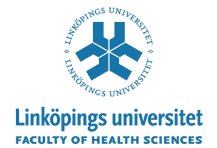 |
Visa svensk kursplan |
|
COURSE CATEGORY Single subject course MAIN FIELD OF STUDY Medical Biology SUBJECT AREA Medical Biology |
COURSE CODE | 8FA221 |
LEARNING OUTCOMES
By the end of the course the students will be able to:
Knowledge and understanding
- Identify and summarize the current status of knowledge within areas of cellular and molecular immunology
- Understand normal regulation of immunity and how aberrations in the regulation can lead to immunological diseases
- Understand the principles of immunomodulatory treatment and the role of the immune system in development of tumours
Competence and skills
- Plan and implement a given laboratory experiment on immune responses in vitro and evaluate and interpret the generated data
Judgement and approach
- Summarize, present, and evaluate current research in immunology in order to discuss new hypotheses within the area
- Immunogenetics
- Immunopathology
- Methods in immunology, in particular multiple bead array and ELISA for measurement of cytokines and chemokines
- Regulation of the immune system and homeostasis
- Immunological diseases: autoimmunity, allergy, inflammation, infections and immunological aspects of cancer
- Immunotherapy
Specific: In this course lectures, tutorial groups, literature in-depth studies, seminars, and laboratory work are used.
Active participation in the compulsory parts is necessary to pass the course, and assessment of them is carried out continuously. Compulsory parts in this course are: Tutorial groups, laboratory work and seminars.
EXAMINATION
Individual written examination
Written laboratory report; group assignment with individual assessment
Written report and oral presentation of literature study; group assignment with individual assessment
SCOPE OF RE-EXAMINATION
The extent of a re−examination shall be similar to the regular examination.
CHANGE OF EXAMINERS
Students who have failed the course or part of the course twice are entitled to request another examiner for the following examination occasion, unless specific reasons are present.
REGISTRATION FOR EXAMINATION
The procedure for registration should be stated prior to the commencement of each course. In other respects, regulations concerning examination and examiners are applied in accordance with Linköping University policy.
Applicants must also have documented knowledge of English equivalent to Engelska B/Engelska 6; i.e. an internationally recognized test, e.g. TOEFL (minimum scores: Paper based 575 + TWE-score 4.5, and internet-based: Score of 20 (scale 0-30) in written test, total score of 90), IELTS, academic (minimum score: Overall mark of 6.5 and no section below 5.5), or equivalent
The course is carried out in such a way that both men’s and women’s experience and knowledge is made visible and developed.
If the course is withdrawn, or is subject to major changes, examinations according to this course plan are normally offered on a total of three occasions within one year, one of them in close connection to the first examination
|
||||||||||||||||||||||||||||||||||||||||||||||||||||||||||||||||||||||||||||||